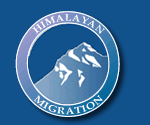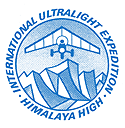

Microlight expeditions to Everest
1986
Dudh Kosi Kites and Kayak Expedition
This September/October British expedition led by Mick Coyne took two Southdown Raven trikes flown by Simon Baker and David Young to make the highest possible landing of any aircraft and to act as reconnaissance for the kayakers, particularly in a deep gorge section which had never been navigated before.
It is thought Baker was the first person to take off in a microlight in Nepal, from Kathmandu. While the kayak expedition spent six days walking in to Lukla, Baker and Young flew the two microlights from Kathmandu to Lamadanda en route to Lukla. When they arrived, the exhaust on Baker’s special 60 Hp three cylinder Robin two-stroke engine was cracked. Instead of returning to Kathmandu they decided to both go in the other standard 440cc machine to to the British Ghurkha camp near Dharan to get it welded. Young recalls “It seemed like it took forever to get off the ground which was surprising as although the place was on top of a hill it was actually lower than Kathmandu. Simon said look back at the strip after we had taken off and I found I was looking up at it. We had to follow a tremendously circuitous course following the river valley to get where we were going, we just could not climb over the hills. I think it was the humidity which was the problem because the machines performed amazingly well in the mountains later on.”
In fact the highest strip the microlights took off from was one the expedition built above Pheriche at 14,500ft, Baker says; “a horrible little rough thing hewn out of rocks”. At about 13,000 ft. not far from Ama Dablam base camp they also “found and cleared an unused strip at Mingbo that was apparently commissioned by Hillary. Very desolate.”
The microlights flew most of the time at full power and amazingly made it to altitudes up to 23,000 ft. Simon Baker with the three cylinder engine flew with passengers from Syangboche at 12,500 ft. and even landed solo on a makeshift 150m strip near Gorak Shep just below Everest Base Camp at about 17,500ft. He recalls “At Gorak Shep the guys cleared the dry lake bed for me. It’s a nasty cold place where you can’t breathe or walk properly. I’m probably biased as I didn’t use oxygen and felt quite poorly for 24 hours. When I arrived to discover that all the rocks were beautifully laid out in 2 rows about 25 ft apart I didn’t have the heart to say that I would have preferred them a little wider!” The machine was subsequently dismantled and portered out because the flight was made in the smaller 440cc 38 hp Robin and attempting take off in a bowl was deemed too dangerous. Possibly the Nepali meaning of the place name; “Graveyard of crows” had an influence too but nevertheless this remains probably the second highest successful landing ever made in an aeroplane*. Baker says “ I’ve since met someone who says the rocks are still in place.”
The larger Robin engine sustained regular exhaust and mounting plate cracks and several flights were made back to Dharan to weld it back up. On one of these trips David Young recalls “On yet another trip out to get something repaired I had an engine seize above Syangboche at around 13,500 ft. but managed to glide the nine miles to Lukla! The main bearings had seized. I remember landing there greatly relieved in front of a party of Aussie trekkers who all applauded and gave me a Fosters. It's just a reminder about taking chances. At Lukla we had the spare engine (my old school Robin with 400 hours on it)”. Lukla airfield is notable for its steep slope ending at the edge of a ravine. Having fitted this engine he “then had to face a test flight down this strip”. David’s luck finally ran out whilst returning to Pheriche from Dharan with the repaired exhaust, he encountered extreme turbulence and crashed at 14,000 ft on the side of the very distinctive mount Ama Dablam sustaining severe internal injuries. He was fortunate that the crash site was not far from the medical aid post at Pheriche (about 2 hours walking) which was manned by two young American volunteer doctors who managed to keep him on a drip and alive until he could be evacuated to Kathmandu by helicopter the next day. “The 'rule' I broke was flying after midday. I think we had worked out that there was firstly too much risk of the anabatic wind bringing cloud up the valleys and secondly a greater risk of unpredictable turbulence and sink. One time we landed at Syangboche and the place was covered in cloud within five or ten minutes of landing - we couldn't believe it from the way the conditions had been when flying.”
The kayak expedition proceeded without the benefit of aerial support down some very extreme and remote white water and successfully made it to the confluence of the Dudh Kosi and Sunkoshi rivers with the minimum of portages but in nine days rather than the planned three. In the meantime Malcolm McBride had flown out from England at a moments notice to build a second machine from the crashed machine and their remaining spares. Young recalls; “I believe my wing was left smashed on the mountain side. Malcolm used the spare wing we had which I am sure was my Puma Sprint wing that I had in Portugal. I didn't think there was much left of the trike. Malcolm also crashed taking off from Lukla, I think he had a power problem on the take off run and turned off the runway into a wall to avoid going over the edge!”. This was repaired again and Baker and McBride flew down hill to meet up with the Kayakers and they all continued in tandem on the final part of the journey to Dharan.
1993
 HIMALAYA
HIGH INTERNATIONAL ULTRALIGHT EXPEDITION
HIMALAYA
HIGH INTERNATIONAL ULTRALIGHT EXPEDITION
So near and yet so far; 80 Minutes over the Himalayas.
By Jan Bem, Expedition leader
It is November 6, 1993, at the Syangboche airstrip, the highest airfield in Nepal. with an elevation of 12,450 feet. At 6 a.m., after scrubbing some frost from the glider wing, we push the trike into takeoff position and hook up the quick release to the ground anchor. I dress in a double cold-weather suit and start the engine. It is about 26F. I put on my helmet with oxygen cannulas, plug in the radio jacks and check the setting on the camera, while the engine is slowly warming up. It is already daylight, but the sun is still hiding behind Thamserku (20,900 feet) which peaks about three miles from the end of the runway.
- After five minutes, the engine is ready for takeoff. Last check of radio and oxygen flow, and I slowly push the throttle to get full power. The engine is running fine, so I squeeze the quick release, and my trike is on the roll. Takeoff takes about 100 yards on the down slope runway with a slight tailwind.
I climb at 400 fpm and keep a little extra airspeed in case there is a wind shear which we have frequently experienced over the edge of this airstrip. On the south side, the terrain drops off over 3,000 feet bottoming in the deep ridge of Bhote Kosi River. Glued to the side of this slope are the blue houses of Namche Bazar, the capitol of the Sherpa tribe. On the north side there is a breathtaking panorama surrounding Mt. Everest.
I circle above the airfield to gain some altitude before I dare head northeast toward Ama Dablam (22,493 feet). This is one of those rare days in the Himalayas when there is no wind, no clouds and no turbulence. Even the almost permanent snow “flag” over Everest is not there. But as I climb through this still air, my trike’s rate of climb slowly diminishes. After about 45 minutes, I reach the service ceiling of this trike at 21,800 feet. The temperature is -15F, but even with the wind chill at 50 miles indicated airspeed, warm clothes and thermal packs make the flight comfortable. The oxygen flow meter shows 2.5 litres/minute and there is no feeling of high altitude discomfort.
I cruise close to Ama Dablam and try to locate our alternate landing site near Pheriche. Seven thousand feet below I see three possible landing sites but there is still the shadow of Ama Dablam hanging over the valley, so I cannot distinguish the orange marking made by our ground crew. Although I cannot see Syangboche airstrip, I know that with no wind conditions, I am comfortably within gliding distance of the airfield. It is the self-preservation instinct which keeps me from straying too far from possible landing sites. Nepalese gasoline of 87 octane to which we add some octane booster from the United States is fouling the engine spark plugs so badly that we are changing them after every flight. Nevertheless, in such beautiful weather I fly a little north and west to see the Everest base camp and the icefall above it, enjoying the view and taking pictures. With almost unlimited visibility, the surrounding scenery is surrealistic. Flying here on a little trike is a mixture of glory and fear. One can understand why so much mysticism is attached to these mountains.
Five miles northeast is the peak of Mt. Everest, the original goal of this expedition, but it is out of my reach. The high altitude trike which I built in the last three years is abandoned on Lukla airstrip 20 miles south of Everest, due to mechanical problems. There was no hope of quick repairs in this remote corner of the earth.
After 80 minutes in the air it is time to go back. Coming back to Syangboche I feel sorry that this flight of my life is coming to an end. But it’s a great reward for years of preparations and the hectic work of the last three months in mounting this expedition. This flight was my Himalaya High ‘93.
The following story was written by Jiri Zitka and translated by Yana Bem
We arrived in Nepal with one idea, to fly around and over the third pole of the world - over Mount Everest. The highest mountain has quite a few names, given it by the nations living for many centuries nearby. The name “Chomolungma”, the goddess mother of the Earth, is possibly the best known. Sherpas from the valley Solo Khumba have yet another name: “The mountain as high, that no bird can fly over it.” We believed that the wings of our trikes will prove this wrong.
Englishmen David Young and Simon Baker were the first ones to fly trikes in the Himalaya region. They were there together with the kayak expedition. They were flying around the airfield in Syangboche, which has an elevation of 3,760 meters above sea level and only 24 kilometers from Mt. Everest. David Young ultralight crashed on the hillside, not far from Hillary’s hospital in Khumba. David himself was transported with serious injuries to Kathmandu. Simon Baker landed at the base of the mountain named Kala Pattar. There his trike had to be disassembled and with the help of Sherpa porters transported down to the airport in Lukla.
Jan Bem, expedition leader of Himalaya High, got the idea of flying over Mount Everest on his pleasure trip to Nepal in 1987. After the return to his home in Miami Beach in the USA, he buried himself in studying technical books and started to modify the engine Rotax 912 for flights in high altitudes. All these experiments and tryouts lasted almost four years. During that time Jan Bem, otherwise experienced pilot of seaplanes, balloons and ultralights, improved his flying capabilities on the trike.
The opportunity for the final preparations for Himalaya High Expedition was made possible by LAA, the Czech Amateur Society, in his homeland, the Czech Republic. He participated in our first international ultralight race, “Masaryk Cross Country”. He took second place, but the next year he was already first.
May, 1993 - The second annual “Masaryk Cross Country” race is on. Jan Bern receives a fax from Nepal; finally he has received the permit to fly in the Himalayas. His five-year dream is starting to materialize. And right there at the races Jan is offering to the pilot Pavel Krizan and to myself, the unique opportunity to participate in the expedition.
I recommend the film making team of Jirka Cerny, with whom I successfully cooperated last year at the ultralight crossing of the Berings Straight. A team of mountain climbers is put together by Jan’ s sister (and also his navigator), Sasa Tilingerova. The other and very complicated agenda is arranged by Nada Murmakova. Altogether, a group of thirteen enthusiasts.
In Kathmandu, a city in Nepal, thirteen of us arrived on the thirteenth of October. We stayed there about fourteen days. In those days the toughest job was Jan’s. The amount of bureaucracy and administration was incredible; papers, more papers and permissions. Since he was the only one speaking fluent English, he had to arrange all the necessities, and I must admit that to deal with the local officials was not an easy task. They had all the time in the world and everything took forever. Finally we had a lucky break - the deputy minister of aviation, Baskanta Upadkya, expressed a desire to try to fly in an ultralight. Of course we gladly fulfilled his desire and finally everything took a turn for the better.
The twenty-fourth of August we finally had the blessings not only of the local officials, but also from the local priest, who sacrificed two roosters and some blessed fruit for us. Finally we could start. Direction Lukla, the airstrip before the gate to the National Park Sagarmatha, about 180 km from Kathmandu.
First we flew above the ancient city of Bhakthapur, then we follow the river Sun Kosi in the direction of the airstrip in Lamidada, where we plan to land for a while to check everything and then go on. We are flying at the altitude of 2,800 meters, underneath us and beside us are incredibly steep mountainsides, which all the way to the top, are carved out by narrow strips of fields. It seems to be incredibly exotic to us. On the very tops of the mountains are stone huts. For goodness sakes, who can live there? But even the steepest mountainsides are wrinkled with the ribbon trails witnessing the human presence. Coming to Lamidada, we fly quite high. We don’t think we should lose the altitude, therefore we talk it over on the aircraft radios and we decide to tempt the fate and fly about 40km further directly to Lukla.
We will follow another river, Dudh Kosi, the ‘milky' river, that starts somewhere near the base of Mount Everest. The valley is getting narrower and narrower and the solid cloud cover is getting dangerously low. It feels like we are willingly flying into the dragon jaws. The river below us is boiling with wild currents and above it we are trying to squeeze the last drops of gasoline from our tanks. Finally the airstrip in Lukla is in sight. Jan is squeezing in front of me and lands first. Once on the ground he is telling me that the last few minutes his engine was misfiring and he was barely able to keep the altitude. And it was the beginning of troubles with the experimental engine.
After five days of acclimatization in Lukla, we wanted to depart to our base camp in Syangboche, the highest airfield in the Himalayas, but Jan’s engine refused to start again. Well I had to depart myself. We agreed that he will try to fix the engine and catch up with me the next day. Our ground crew departed toward the airfield in Syangboche two days earlier with fourteen yaks fully loaded. I met the crew the same day. For Jan we had to wait a few more days, and all of a sudden he appeared. He was walking uphill quite gingerly, with the help of expedition oxygen, but he carried bad news. He didn’t manage to repair the experimental engine.
For Jan Bem it was the most difficult days. The engine, custom turbocharged Rotax, which he worked on and successfully tried out in the Rocky Mountains and in the Czech Republic, failed just before the final attempt. It didn’t even help to fly back and forth to Kathmandu with new parts. Maybe if there were more time. But the weather was getting worse and there were only a few days left on the permit.
We had to devise an alternative program. Our new target became a mountain, Ama Dablam, with an elevation of 6,856 meters, a gorgeous mountain right next to Mount Everest. Jan stripped his trike of all the lighter parts that we could use for the other VLM. A lighter wing, parachute, basically everything we could use to improve the other trike. Finally we were airborne again. For Jan Bem and Pavel Krizan, it was a tremendous elation. Because this is what they came to do.
Jan flew again, 6,850 meters - almost to the top, and he came back incredibly happy. We started to believe it would work out. Suddenly, the weather got incredibly bad. We were desperate. Our film crew were shaking their heads in disbelief. For goodness sakes, what will the film be about?
The eighth of November we decided. We stripped the trike of everything that was not absolutely necessary. I started out. The engine was in excellent condition, and in places I was climbing 3 meters per second. To 4,500 - 5,000 meters the climb rate was great, but then all of the sudden it was like I hit the ceiling. No matter how hard I tried, I could not get any higher. The turbulence became so incredible that I felt like I was on a roller coaster. It didn’t make sense to try the luck any longer.
Two days later, Jan wakes us up at 6:00am. We overslept, maybe we wanted to sleep through all that disappointment. The weather looked the same, only at the top of Mt. Everest there was not a flag caused by high winds. At 6:45am I am ready for take-off. I try to soar up the mountainside of Thamserku, elevation 6,808 meters. I climb to 6,300 meters. Then I fly toward the Ama Dablam, and all of a sudden soaring takes me above the top of Ama Dablam. “I am above it I am above it”, I scream into the radio. From the headphones I hear an enthusiastic “hurrah” from my friends. I’m passing the top of Ama Dablam with 100 meters to spare. Euphoria from the victory is momentarily stronger than my sanity. Everest is so close, maybe I can get there, maybe I can still make it. I continue to climb higher and my altimeter reads 7,050 meters, but my, Jan’s and Pavel’s dream is still too far away and two thousand meters higher. Suddenly I came to my senses. Time to go back. It’s beyond the capability of the machine which is carrying me. I must go back. Dead men tell no tales.
After the landing in Syangboche, Pavel Krizan is ready to fly. The gods of the Himalayas are quite friendly today and allow him to look at the top of Ama Dablam. He even climbed a little higher than I did - 7,150 meters. His flight lasted two hours and five minutes. His engine had to be restarted twice, he landed with a few drops of gas left and no oxygen. But he was victorious and happy. “If you would have made it over Mt. Everest, I had a penalty ready for you of $25,000 said the deputy of the ministry of aviation later. We didn’t make it. But we all returned alive, all we know now, how to do it better next time. Mount Everest is still waiting.
FACTS ABOUT EXPEDITION
October 1992: Apply for permit to fly in Nepal
June 1993: Permit to fly is granted
July-September 1993: Preparation for expedition
October 10 - November 20, 1993: Expedition
3 Pilots
10 Ground and Filming Crew
38 Porters
2 Trikes with 14 meter gliders, 1 Cosmos, 1 ESO 14
1 Powered by Rotax 532 and 3 blade in flight adjustable Ivoprop
1 powered by Rotax 912 custom turbo-charged
42 Total hours flown in Himalaya
Maximum Altitude reached soaring over Ama Dablam: 23,460 feet
No casualities.
Note
The highest recorded landing in an aeroplane was performed by Emil Wick in the prototype Pilatus Porter ‘Yeti’ at 5,700m, whilst supporting the Swiss Dhaulagiri expedition of 1960.











